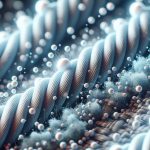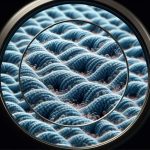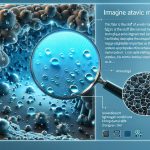Just as Prometheus brought fire to mankind, advancements in antimicrobial fabrics have ignited a revolution in medical textiles. You'll find that these innovations, like silver-infused textiles and copper-embedded fabrics, are now at the forefront of reducing healthcare-associated infections. What makes these fabrics truly groundbreaking is their ability to integrate nanotechnology and sustainable practices, ensuring long-term efficacy. So, how do these materials work to provide such robust protection, and what does this mean for the future of healthcare? Join us as we explore the intricate mechanisms and promising trends shaping this pivotal field.
Table of Contents
Key Takeaways
- Nanotechnology enhances antimicrobial properties by embedding nanoparticles that release agents in a controlled manner.
- Silver-infused textiles disrupt bacterial membranes for effective infection control.
- Copper-embedded fabrics create barriers against bacteria and viruses in healthcare settings.
- Sustainable practices in fabric engineering emphasize the integration of biodegradable antimicrobial agents like chitosan.
- Advanced weaving techniques ensure long-lasting antimicrobial efficacy and fabric durability.
Evolution of Medical Textiles
Medical textiles have continuously developed to meet the ever-evolving demands of healthcare environments. As you explore their history, you'll notice that early medical textiles were basic, often failing to meet the strict standards we expect today. Initially, simple cotton and linen were used, but they lacked the advanced antimicrobial properties needed to combat infections.
By the mid-20th century, the impact of technological advancements began to reshape this landscape. Synthetic fibers like polyester and nylon were introduced, providing improved durability and resistance to wear. These materials opened the door for incorporating antimicrobial agents directly into the fabric, greatly enhancing their effectiveness.
As you track the evolution, the late 20th and early 21st centuries mark a crucial turning point. Innovations such as nanotechnology and bioengineering allowed for even more precise integration of antimicrobial properties. This progression has had a remarkable impact on reducing healthcare-associated infections and improving patient outcomes.
Understanding the rich history of medical textiles provides you with a thorough view of how far we've come. It underscores the importance of continual innovation in creating safer and more efficient healthcare environments.
Types of Antimicrobial Fabrics
Antimicrobial fabrics come in various forms, each offering unique benefits tailored to specific healthcare needs. When you're selecting the right fabric, understanding its antimicrobial properties and the relevant testing protocols is essential.
These fabrics undergo rigorous performance testing to confirm they meet the high standards required in medical environments. Here's a snapshot of commonly used antimicrobial fabrics:
- Silver-Infused Textiles: Known for their broad-spectrum antimicrobial properties, silver ions disrupt bacterial cell membranes, making these fabrics ideal for wound care and surgical gowns.
- Copper-Embedded Fabrics: Copper's antimicrobial activity is well-documented, providing an effective barrier against bacteria and viruses. These fabrics are often used in hospital linens and patient garments.
- Quaternary Ammonium Compounds (QACs): These fabrics are treated with QACs, which offer long-lasting antimicrobial effects. They're especially useful in high-contact surfaces like bed sheets and curtains.
- Chitosan-Based Textiles: Derived from chitin in crustacean shells, chitosan offers natural antimicrobial properties and is biodegradable, making it perfect for disposable medical products.
- Polyhexamethylene Biguanide (PHMB) Treated Fabrics: PHMB is a powerful antimicrobial agent that's used in various medical textiles to reduce infection risks.
Mechanisms of Action
Understanding the specific mechanisms by which antimicrobial fabrics combat pathogens is crucial in selecting the right material for your healthcare needs. These fabrics work by employing various strategies to inhibit or destroy microorganisms, guaranteeing the textile maintains its functionality.
One common method involves embedding antimicrobial agents like silver ions or copper into the fabric. These agents disrupt essential cellular processes in microbes, rendering them unable to reproduce or survive.
Another approach leverages bioactive molecules that create hostile environments for pathogens through alterations in pH or moisture levels. This method not only disrupts microbe interactions but also helps prevent the development of antimicrobial resistance.
By interfering with the microbial cell walls and metabolic pathways, these fabrics act as a formidable barrier against contamination.
Advanced fabric development techniques also incorporate nanoparticles that release antimicrobial agents in a controlled manner, effectively maintaining long-term efficacy. These sophisticated methods ensure that antimicrobial properties are sustained even after multiple washes, making them ideal for medical settings.
Understanding these mechanisms allows you to make informed decisions, guaranteeing that the chosen antimicrobial fabric will offer robust protection and durability, tailored to your specific healthcare requirements.
Benefits of Antimicrobial Fabrics
You'll find that integrating antimicrobial fabrics into your daily life offers a range of significant benefits, especially in environments where hygiene is crucial. These fabrics are designed not only to improve comfort but also to provide a strong defense against harmful microorganisms. By choosing antimicrobial textiles, you can effectively achieve both odor control and infection prevention, which are essential in maintaining a healthy living or working space.
Consider how these advantages manifest in your daily routine:
- Improved Odor Control: Antimicrobial fabrics inhibit the growth of bacteria that cause unpleasant odors, keeping your clothes and surroundings fresher for longer.
- Infection Prevention: These fabrics reduce the risk of infections by minimizing the presence of harmful microbes on surfaces and clothing.
- Longevity of Products: Since antimicrobial treatments can prevent bacterial degradation, your textiles will last longer and maintain their quality over time.
- Hygiene Assurance: Ideal for healthcare settings, antimicrobial fabrics guarantee that hygiene standards are consistently met, providing peace of mind to both patients and healthcare professionals.
- Versatile Applications: From medical scrubs to sportswear, antimicrobial fabrics are suitable for various uses, making them a versatile choice for enhancing hygiene in multiple contexts.
Innovations in Fabric Technology
Recent breakthroughs in fabric technology have revolutionized the way antimicrobial properties are integrated into textiles. You can now find materials that not only inhibit microbial growth but also excel in fabric engineering and sustainability. Engineers have developed advanced methods to embed antimicrobial agents directly into fibers, ensuring long-lasting effectiveness without compromising the fabric's integrity. This means you get textiles that aren't only protective but also environmentally friendly.
In terms of textile design, these innovations have paved the way for fabrics that offer superior functionality. Imagine garments that not only protect you from harmful microbes but also provide comfort, breathability, and durability. Advanced weaving techniques and the use of nanotechnology allow for precise control over the distribution of antimicrobial agents, maximizing their efficacy.
Sustainability is another vital aspect. Modern fabric engineering focuses on using renewable resources and reducing waste in the production process. By incorporating sustainable practices, these new textiles not only safeguard your health but also contribute to a healthier planet.
Applications in Healthcare
In healthcare settings, antimicrobial fabrics play a pivotal role in preventing the spread of infections and ensuring patient safety. These advanced textiles are indispensable in various applications, from surgical drapes to wound care, due to their ability to inhibit the growth of harmful microorganisms.
Consider these key applications:
- Surgical Drapes: By incorporating antimicrobial properties, surgical drapes provide a sterile barrier, notably reducing the risk of infection during procedures.
- Antimicrobial Dressings: These dressings are critical in wound care, as they prevent bacterial colonization and promote faster healing.
- Hospital Linens: Bedsheets, pillowcases, and patient gowns made from antimicrobial fabrics help maintain a hygienic environment, minimizing cross-contamination.
- Staff Uniforms: Healthcare workers' uniforms with antimicrobial features offer an additional layer of protection, safeguarding both staff and patients.
- Medical Device Covers: Antimicrobial fabrics are used to cover and protect medical devices, ensuring they remain free from microbial contamination.
Challenges and Limitations
When contemplating antimicrobial textiles, you need to think about the challenges of cost and scalability. These textiles can be expensive to produce, and scaling up for mass production isn't always straightforward.
Additionally, evaluating their long-term durability and efficacy is essential to guarantee they remain effective over time.
Cost and Scalability
One of the biggest hurdles for antimicrobial fabrics is the high production cost, which can impede widespread adoption. When you delve into a cost analysis, you'll find that the raw materials, specialized treatments, and advanced manufacturing processes required push the price point higher than conventional textiles. This affects both production efficiency and the final retail cost, making it difficult for these innovative fabrics to enter mainstream markets.
To better understand the financial landscape, consider the following factors:
- Raw Material Costs: High-quality, antimicrobial agents and fibers are pricier than standard materials.
- Specialized Equipment: Manufacturing these fabrics often requires state-of-the-art machinery, which adds to the initial investment.
- Energy Consumption: The processes involved can be energy-intensive, driving up operational costs.
- Research and Development: Ongoing costs for innovation and improvement in antimicrobial efficacy contribute to the financial burden.
- Economies of Scale: Smaller production runs mean higher per-unit costs, limiting the potential for price reductions through mass production.
Durability and Efficacy
Durability and efficacy are critical concerns when assessing the practicality of antimicrobial fabrics in everyday use. It's crucial to verify that these fabrics can withstand repeated laundering and constant wear without compromising their protective qualities. Fabric durability directly impacts antimicrobial efficacy, as the fibers and treatments must remain intact to provide continuous protection.
One challenge you'll encounter is the degradation of antimicrobial treatments over time. Frequent washing, exposure to harsh detergents, and regular wear can diminish the fabric's ability to ward off harmful microbes. It's vital to consider how well the antimicrobial properties are integrated into the fabric. Surface-applied treatments may wear off more quickly compared to those embedded into the fibers during the manufacturing process.
Additionally, balancing antimicrobial efficacy with fabric durability poses another limitation. Some treatments might be highly effective at killing microbes but can weaken the fabric, reducing its longevity. On the other hand, more durable fabrics might compromise on the level of antimicrobial protection.
To achieve the best outcomes, you should look for fabrics that strike a balance between robustness and sustained antimicrobial action. Continuous advancements in this field aim to enhance both aspects, but current limitations still require thoughtful evaluation.
Future Trends in Medical Textiles
You'll soon see medical textiles incorporating innovative antimicrobial technologies, enhancing patient care and safety.
Imagine smart fabrics capable of monitoring health metrics and delivering treatments.
Plus, expect a shift towards sustainable textile solutions that reduce environmental impact while maintaining effectiveness.
Innovative Antimicrobial Technologies
As medical textiles continue to evolve, innovative antimicrobial technologies are paving the way for more effective and safer healthcare solutions.
You'll find that the application of nanotechnology and the infusion of silver into textiles are at the forefront of these advancements. Nanotechnology enables the creation of fabrics at the molecular level, offering unparalleled control over antimicrobial properties.
Silver, known for its potent antibacterial qualities, is being seamlessly integrated into fibers to create textiles that inhibit microbial growth and reduce infections.
Consider these cutting-edge advancements:
- Nanotechnology application: Nanoparticles are woven into fabrics, providing long-lasting antimicrobial effects without compromising comfort.
- Silver infused textiles: Silver ions are embedded within fibers, ensuring continuous antimicrobial action and reducing the spread of pathogens.
- Copper oxide fabrics: Leveraging copper's natural antimicrobial properties, these textiles kill bacteria upon contact.
- Chitosan-based materials: Derived from natural sources, chitosan offers biocompatibility and effective microbial resistance.
- Photocatalytic textiles: These fabrics use light-activated processes to neutralize pathogens, providing a sustainable approach to infection control.
Smart Fabric Integration
Building on these technological advancements, smart fabric integration represents the next frontier in creating responsive and adaptive medical textiles. You're entering an era where medical textiles not only protect but also monitor and respond to patients' needs in real-time. Wearable sensors embedded in intelligent clothing can continuously track critical signs, such as heart rate and body temperature, offering unprecedented levels of patient care and early detection of potential health issues.
Imagine a hospital gown that alerts healthcare providers about a patient's declining condition or a bandage that monitors wound healing and adjusts its antimicrobial properties accordingly. These innovations aren't just concepts; they're shaping the future of medical textiles.
Here's a snapshot of smart fabric capabilities:
| Feature | Benefit |
|---|---|
| Wearable Sensors | Continuous health monitoring |
| Intelligent Clothing | Adaptive response to patient needs |
| Real-time Data Collection | Early detection of health issues |
| Enhanced Patient Care | Proactive and personalized treatment |
Sustainable Textile Solutions
In an era increasingly defined by environmental awareness, sustainable textile solutions are revolutionizing the future of medical textiles. You're witnessing a transformative shift toward eco-friendly alternatives and sustainable manufacturing practices that promise a cleaner, greener future for medical fabrics. This movement isn't just a trend; it's a necessity driven by the urgent need to reduce the environmental footprint of the textile industry.
To give you a clearer picture, consider the following key advancements:
- Bio-based fibers: Utilizing natural, renewable resources like bamboo, hemp, and organic cotton to create medical textiles.
- Recycled materials: Incorporating post-consumer waste, such as recycled polyester from plastic bottles, into fabric production.
- Waterless dyeing technologies: Implementing innovative techniques that drastically cut down water usage and pollution.
- Green chemistry: Developing non-toxic, biodegradable antimicrobial treatments that maintain fabric functionality without harming the environment.
- Energy-efficient processes: Adopting manufacturing methods that minimize energy consumption and carbon emissions.
These sustainable approaches not only enhance the ecological footprint but also guarantee that the medical textile industry remains resilient and forward-thinking.
Frequently Asked Questions
How Do Antimicrobial Textiles Affect Skin Sensitivity and Allergies?
Antimicrobial textiles can enhance skin sensitivity and allergy prevention. You'll find that these fabrics minimize skin reactions, reducing the likelihood of allergies while maintaining comfort. They're designed to keep your skin healthy and irritation-free.
Are There Eco-Friendly Options for Antimicrobial Medical Textiles?
Imagine a time machine to a greener future. You'll find eco-friendly options that use sustainable manufacturing processes, ensuring antimicrobial medical textiles are both effective and environmentally responsible. Gain mastery by choosing these green innovations.
Can Antimicrobial Fabrics Be Used in Consumer Clothing?
Yes, you can absolutely use antimicrobial fabrics in consumer clothing. With rising consumer demand and shifting fashion trends, incorporating these fabrics meets the need for hygiene and style, offering a competitive edge in the market.
How Are Antimicrobial Properties Tested and Verified in Textiles?
Testing antimicrobial properties in textiles is like scrutinizing a fine piece of art. You'll use testing methods such as agar diffusion and verification processes including microbial culture counts to guarantee effectiveness and reliability.
What Are the Costs Associated With Producing Antimicrobial Fabrics?
When analyzing costs, you'll find that antimicrobial fabric production involves significant expenses. Cost analysis includes raw materials, specialized treatments, and production challenges. Overcoming these challenges can increase overall costs, but it guarantees high-quality, effective antimicrobial textiles.
- Closest Fabric to Kevlar: Substitutes for Budget-Friendly Projects - June 21, 2025
- Encased Kevlar Fabric: Reinforcing Gear for Enhanced Safety - June 21, 2025
- What Does Kevlar Fabric Feel Like? Tactile and Thermal Analysis - June 21, 2025







